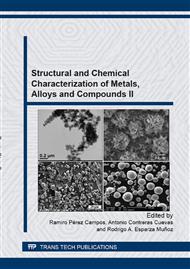[1]
T. Zhang, S. Mubeen, N.V. Myung, M.A. Deshusses, Recent progress in carbon nanotube-based gas sensor, Nanotechnology 19 (2008) 1-14.
DOI: 10.1088/0957-4484/19/33/332001
Google Scholar
[2]
Y. Wang, J.T.W. Yeow, A review of carbon nanotubes-based gas sensors, J. Sensors (2009) 1-24.
Google Scholar
[3]
M. Vesali, A. Khodadadi, Y. Mortazavi, O. Alizadeh, F. Pourfavaz, S. Mosadegh, Functionalization of carbon nanotubes using nitric acid oxidation and DBD plasma, World Acad. Sci. Eng. Technol. 49 (2009) 177-179.
Google Scholar
[4]
A. Hirsch, Functionalization of single-walled carbon nanotubes, Angew. Chem. Int. 41 (2002) 1853-1859.
DOI: 10.1002/1521-3773(20020603)41:11<1853::aid-anie1853>3.0.co;2-n
Google Scholar
[5]
V. Datsyuk, M. Kalyva, K. Papagelis, J. Parthenios, D. Tasis, A. Siokou, I. Kallitsis, C. Galiotis, Chemical oxidation of multiwalled carbon nanotubes, Carbon 46 (2008) 833-840
DOI: 10.1016/j.carbon.2008.02.012
Google Scholar
[6]
G. Jiménez, J. Riu, F. Xavier, Gas sensors based on nanostructured materials, Analyst 132 (2007) 1083-1099.
Google Scholar
[7]
E.H. Espinosa, R. Ionescu, C. Bittencourt, A. Felten, R. Erni, G.V. Tendeloo, J.J. Pireaux, E. Llobet, Metal decorated multi-wall carbon nanotubes for low temperature gas sensing, Thin Solid Films 515 (2007) 8322-8327.
DOI: 10.1016/j.tsf.2007.03.017
Google Scholar
[8]
V. Georgakilas, D. Gournis, V. Tzitzios, L. Pasquato, D.M. Guldi, M. Prato, Decorating carbon nanotubes with metal or semiconductor nanoparticles, J. Mater. Chem. 17 (2007) 2679-2693.
DOI: 10.1039/b700857k
Google Scholar
[9]
J.M. Planeix, N.Coustel, B. Coq, V. Brotons, P.S. Kumbhar, R. Dutartre, P.Geneste, P. Bernier, P.M. Ajayan, Application of carbon nanotubes as supports in heterogeneous catalysis, J. Am. Chem. Soc. 116 (1994) 7935-7936.
DOI: 10.1021/ja00096a076
Google Scholar
[10]
M. Penza, G. Cassano, R. Rossi, M. Alvisi, A. Rizzo, M.A. Signore, Th. Dikonimos, E. Serra, R. Giorgi, Enhancement of sensitivity in gas chemiresistors based on carbon nanotubes surface functionalized with noble metal (Au, Pt) nanoclusters, Appl. Phys. Lett. 90 (2007) 173123.
DOI: 10.1063/1.2722207
Google Scholar
[11]
A. Star, V. Joshi, S. Skarupo, D. Thomas, J.C.P. Gabriel, Gas sensor array based on metal decorated carbon nanotubes, J. Phys. Chem. B 110 (2006) 21014-21020.
DOI: 10.1021/jp064371z
Google Scholar
[12]
C. Encarnación, J.R. Vargas, J.A. Toledo, M.A. Cortes, C. Angeles, Pt nanoparticles on titania nanotubes prepared by vapor-phase impregnation-decomposition method, J. Alloy Comp. 495 (2010) 458-461.
DOI: 10.1016/j.jallcom.2009.10.232
Google Scholar
[13]
R. Andrews, D. Jacques, A.M. Rao, F. Derbyshire, D. Qian, X. Fan, E.F. Dickey, J. Chen, Continuous production of aligned carbon nanotubes: a step closer to commercial realization, Chem. Phys. Lett. 303 (1999) 467-474.
DOI: 10.1016/s0009-2614(99)00282-1
Google Scholar
[14]
S. Porro, S. Musso, M. Vinante, L. Vanzetti, M. Anderle, F. Trotta, A. Tagliaferro, Purification of carbon nanotubes grown by thermal CVD, Physica E 37 (2007) 58-61.
DOI: 10.1016/j.physe.2006.07.014
Google Scholar
[15]
L. Vaisman, H.D. Wagner, G. Marom, The role of surfactants in dispersion of carbon nanotubes, Adv. Colloid Interfac. 128 (2006) 37-46.
DOI: 10.1016/j.cis.2006.11.007
Google Scholar
[16]
S. Banerjee, T. Hemraj, S.S. Wong, Covalent surface chemistry of single walled carbon nanotubes, Adv. Mater. 17 (2005) 17-29.
DOI: 10.1002/adma.200401340
Google Scholar
[17]
E. Torres, J.R. Vargas, A.M. Robledo, Synthesis and electrochemical characterization (HER-NER) of platinum based materials supported on a carbon nanotube matrix, Materials Science Forum 691 (2011) 99-104.
DOI: 10.4028/www.scientific.net/msf.691.99
Google Scholar
[18]
L. Valentini, F. Mercuri, I. Armentano, C. Cantalini, S. Picozzi, L. Lozzi, S. Santucci, A. Sgamellotti, J.M. Kenny, Role of defects on the gas sensing properties of carbon nanotubes thin films: experiment and theory, Chem. Phys. Lett. 387 (2004) 356-361.
DOI: 10.1016/j.cplett.2004.02.038
Google Scholar
[19]
W. Wongwiriyapan, S.I. Honda, H. Konishi, T. Mizuta, T. Ikuno, T. Ito, T. Maekawa, K. Suzuki, H. Ishikawa, K. Oura, M. Katayama, Single wall carbon nanotubes thin film sensor for ultrasensitive gas detection, Jpn. Appl. Phys. 44 (2005) L482-L484.
DOI: 10.1143/jjap.44.l482
Google Scholar


